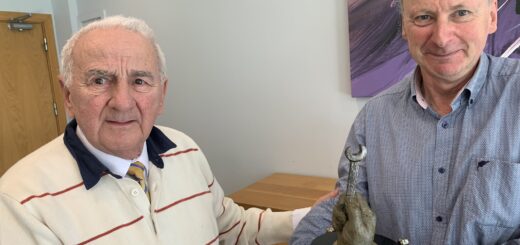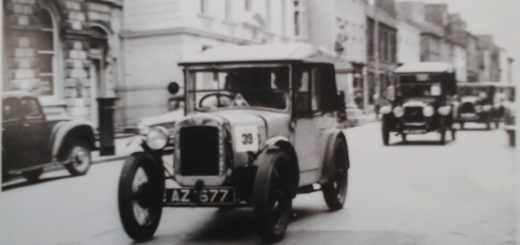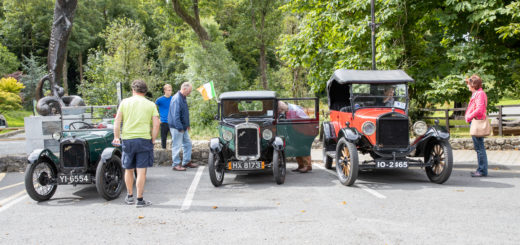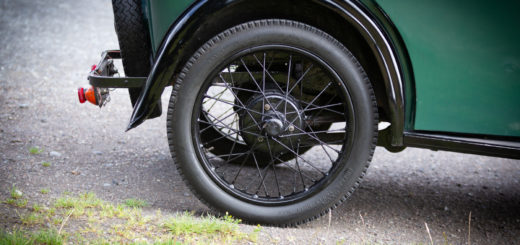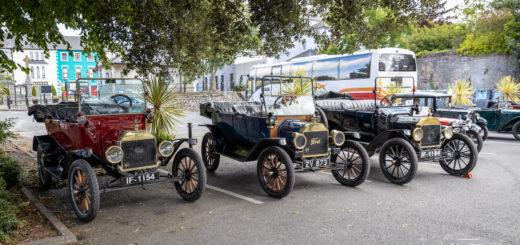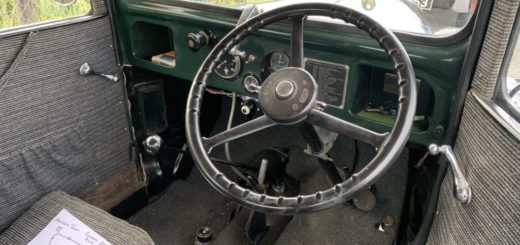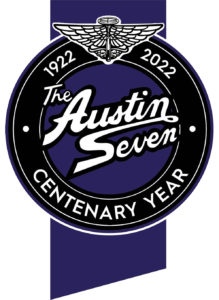A Brief History of the Austin Motor Company
Share this
Herbert Austin – The Early Years
Born in November 1866, the son of a farmer in Buckinghamshire, England, Austin moved at a very early age to Yorkshire where his father became a farm bailiff (or manager) to Earl Fitzwilliam. On leaving school and Commercial college he briefly worked in an uncle’s Architects practice and was due to become apprenticed to the Great Northern Railway but instead moved, around 1883, to Melbourne, Australia to work with another uncle in an engineering firm, moving on to employment in a printing machine firm and a foundry within three or four years.
In 1887 he married Ellen Dron and again changed jobs becoming manager at another engineering works who were making parts for a mechanical sheepshearing machine invented by F.Y. Wolseley. Herbert Austin must have been good at his job as he soon became an engineer at Wolseley’s firm. Wolsley – an immigrant from Dublin – deciding that his business would do better in England, in 1893, set about transferring his works there with Austin as General Manager.
Thus Herbert at 27 with a wife, and by then a young daughter, returned to his homeland . The Wolseley Sheepshearing Company set up a factory in Birmingham and as well as making the shearing machines soon diversified into production of parts for bicycles and machine tools. Inevitably – as the novelty for motoring in Britain was by then beginning to take hold – Austins talents led him to designing and making a three-wheeled horizontal engined car (1896) and soon Wolseleys were making and selling their own small range of cars.
In 1901 the firm was acquired by the shipbuilding empire of Vickers Sons and Maxim, Austin becoming a director of the firm. Within a few years however (as pressures to develop cars along lines he disagreed with) became too great, Austin took the big step of leaving to establish his own car manufacturing company
The Austin Motor Company
Infancy
Registered in late 1905 – early investors were F. Kayser and Harvey du Cros – the firm settled on an unused and run down printing works at Longbridge, Birmingham as the ideal site for building cars and had much potential for expansion. Obviously Herbert, now 38 years old, was still very ambitious. Setting up and equipping the factory took quite a while and the first cars didn’t leave the works until 1906.
At first production was limited to a 25/30hp four cylinder ‘T’ head model but the firm, by 1907, had made some 150 vehicles and grown to employ 400 people. That year a 15 hp model was added and by 1908 Austin was even offering a Grand Prix racing/sports model.
Growth continued – in ’09 they started building a 7 hp single cylinder model (also sold as a’Swift’), a 50 hp model followed in 1913 and by the outbreak of the Great War in 1914 the firm had 2000 employees and had become a public company. The Austin range included Commercial vehicles and Austin even found time to take the Water speed record in speedboats powered by his own’ V’ engines in 1910/11.
Growing Up
The Great War meant that the company grew up quickly and expanded to keep pace with the production of military supplies – in 1914 they produced just under 1000 cars and during the years to 1918 made 650 large guns, over 2000 Aeroplanes, 500 Armoured cars (one survives in Russia) and around 8 million Shell cases!
Tragedy personally struck Herbert Austin when his only son Vernon was killed by a sniper in 1917 but he found comfort in his work and ‘Pa’ Austin – as he became known to his employees ploughed on with enviable energy – he established a small ‘village’ of wooden bungalows for employees near to the factory and at the end of hostilities stood for Parliament and became (for around 6 years) an M.P.
For the new peacetime market Austins decided on a single model ‘mass production‘ policy – heavily influenced by the way in which Henry Ford was operating – and an ‘Austin 20’ of 3.6 litres was offered. In 1920 and ‘21 only around 2700 were sold and the company ran into deep financial trouble. A receiver was appointed (although Austins were allowed to continue trading) and it was decided to scale down the ‘20’ to appeal to a wider market and add this to the range as a ‘twelve/four’ 1.6 litre alternative.
Maturity
Herbert Austin – as a personal project as his fellow directors wouldn’t finance it – was convinced that a ‘baby‘ car would sell well to the owners of motorcycle/sidecar combinations. Back in 1917 a young lad named Stan Edge had joined the firm – initially working in the Aero drawing office and Stan, then only 18, was seconded to work on the design at Austins home (on a drawing board he’d set up in his ‘billiard room’).
The story has been told many times of how Stanley worked seven days a week from September 1922 to Easter ’33 on the initial design drawings. Then, with some secrecy in a sectioned off part of the factory, the ’fast tracked’ production of the prototype Austin Sevens were completed by Whitsun that year. The Seven was shown to the press in July and went on sale at the October motor show (1923).
Over the next 16 years nearly 300,000 Sevens were made, progressing with gradual updating through the original ‘chummy’ open bodystyle through ‘box’ like saloons and ‘Ruby’ versions in the process. The Seven – together with the new 12-four (which became famous as the archetypal London Taxi) sold well and the company was able to become solvent again. The ‘roaring’ twenties also saw production of Austin Commercial vehicles and Tractors expand. The Austin’ Whippet’ light aeroplane also had some small success.
Middle Age Spread
The Thirties were a time of ‘brand loyalty’ when many folk formed loyalties for life with a single brand. Austins had introduced many to motoring with the ‘Seven’ and in 1932 catered for the growing family by bringing to the range a ‘Ten’, a four cylinder four door 1125cc model. This developed through various bodystyles – such as the ‘Litchfield’ and ‘Eton’ – and went on becoming the 1937 ‘Cambridge’ saloon and ultimately the basis for the post war A40 ‘Devon’.
Late the previous decade a 16 hp Saloon had entered the range and Austin added a new 6 cylinder ‘20’ in 1931. In the second half of the decade – as war with Germany was looming on the horizon – Herbert Austin was heavily involved with setting up the governments ‘shadow factory’ scheme for re-armament. The Austin Company own ‘shadow factory’ meant substantial expansion at Longbridge and during the run up and duration of the war produced a phenomenal amount of vehicles and components for all sorts of armaments.
Lancaster bombers, 330 of them, were made at Longbridge ‘East Works’ then assembled at and flown out from Elmdon Airfield (now Birmingham International Airport). In recognition Austin (by then already Sir Herbert) in 1936, had been created Baron ‘Lord Austin of Longbridge’. By 1938 Austin, being then well over 70, saw that his days at the top were coming to an end and recruited Leonard Lord – (who had previously very successfully worked with William Morris at Cowley), as his understudy.
War finally came in 1939 and the domestic car market virtually shut down. Herbert Austin died in May 1941. Leonard Lord, now technical director, became managing director in 1942 (and in another couple of years, Chairman). At the end of the war (1945) the pre-war range of cars was re-introduced. New UK post war Government policy was to concentrate on exports (indeed the fist British car to go to the USA after the war was an Austin Ten) and this then lead to the development of new Austin Models.
Love?
Vanden Plas – the coachbuilding company, was taken over by Austins in 1946. In 1947 the first of the postwar Austin models – the A40 Devon – (1098cc 48hp) was launched, followed in 1948 by a US influenced design A90 ’Atlantic’, a soft top style which was not very well received by the UK market and was short lived. In the early ‘50’s a new ‘baby’ 803cc Austin – the bubble shaped A30 and its bigger brother the ‘Somerset’ set a style that gained more favour, the A30 becoming uprated to 948cc (the A35) and surviving in the range ‘till 1962.
1952 was a landmark year which saw the Austin and rival Morris concerns join together (more a takeover of Morris by Austin) to become the British Motor Corporation – BMC. The Morris and Austin names were to continue as were the names of several marques taken into the Morris ‘Nuffield’ stable previously.
But it cannot be ignored that in the following years many of these other ‘brands’ ran with Austin designed engines – Riley 1.5, MG –B and C, Morris Minor, etc. As for the ‘Austin’ badged cars, new into the range – in 1954 – came the Austin Healey 100, developed by Donald Healey using the old ‘Atlantic’ 2.6 litre engine. The distinctive ‘smiling face’ styling of the Austin Healey ‘frog eye’ Sprite which shared Morris Minor Components introduced the small sports car back into the post war home market.
In ’54 the new restyled 1622cc A40 Cambridge followed and, later in the decade (1958), came the Pinin Farina styled ‘2-box’ A40 which in ‘Countryman’ form must surely be the forerunner of todays ubiquitous ‘hatchbacks’. By 1959, ‘badge engineering’ was blatant e.g. the new A60 Cambridge (Farina bodyshape) which also came in Morris, MG, Riley and Wolseley versions. That year also, the ‘Big’ Austin Healey 3000 made its debut.
The sensation of the year and a fitting end to the decade was the launch of the Alec Issigonis designed ’Austin Seven’ soon to be universally known (and ultimately badged) as the Mini – a Morris version was also soon available. So on into the ‘Swinging’ ‘60’s – when the ‘Mini would become incredibly popular and ultimately copied for its transverse engined front wheel drive layout by virtually all competing car manufacturers.
The ‘Mini’ had notable success with wins in the Monte Carlo rallies (1964 on) driven by Paddy Hopkirk and Henry Lidden. Right at the top of the range the Austin VandenPlas 4 litre 6 cylinder ’Princess’ limousine was almost a Rolls/Bentley rival whilst for the ‘family’ market (in 1962) the Austin – and Morris 1100 merged Farina styling with Issigonis ‘Mini’ style mechanicals. Uprated in 1968 and with the larger 1300 engine it sold extremely well and stayed in the range for many years. Larger ‘Austin 1800’ cars using this layout met some initial sales resistance but were also modestly successful.
And Marriage?
During 1966 BMC had merged with Jaguar – whose founder William Lyons had started in car manufacture back in the late ‘20’s by building ‘Swallow’ bodies onto Austin 7 Chassis – and not too long afterwards BMC/Jaguar-Daimler and Leyland Motors negotiations commenced. In 1968 British Leyland was born – the Austin marque becoming the responsibility of their ’Austin-Rover Group’. The decade came to a close with the introduction of a replacement for the 1100/1300 range – the Austin Maxi (1969) a 1500cc hatchback which with a 1700cc engine soldiered on, despite build quality problems, until 1971.
Dotage?
In 1971 enthusiasm by Austin Rover group for the ‘sports’ image of the MG and Triumph marques rather than Austin Healey led to the demise of the latter name, only a few ‘Sprites’ being made in 1971. Then in 1973 B-L launched the Austin Allegro and followed this in 1975 with the wedge shaped 18-22 range of Austin/Morris/Wolseley cars – the Austin Ambassador and Princess being part of this model choice.
Industrial Relations and confrontation with the Union controlled workforce beset many UK motor manufacturers in the1970’s and British Leyland Austin Rover Group was no exception. Strikes, walkouts and a very questionable build quality affected the loyalty of the buying public and this together with aggressive marketing by Far Eastern vehicle manufacturers (who were being encouraged by the British Government to set up plants in the UK) seriously affected sales of Austin cars.
The 1980 Austin Metro (basically a rebodied Mini 1000/1300) revived the situation somewhat and a hatchbacked Austin Maestro (1.3 and 1.6) introduced in1983 sold a reasonable number. The last ‘ Austin’ car model to be introduced, before alliances with Honda led manufacturing and marketing policy in a different direction, was the Austin Montego in 1984. The Austin name hasn’t surfaced on a new car since 1987 when it was dropped by the Rover Group.
82 years of Austin badged vehicles. Thousands now survive thanks to the legions of Veteran, Vintage and Classic car enthusiasts who won’t let the marque be ignored – and nor should they!
The Austin Name and trade marks are currently owned by MG-Rover Group Ltd.; part of Phoenix Venture Holdings
Set up initially to arrange the 2005 Austin Motor Company Centenary celebrations (8-10 July 2005 in Birmingham) and co-ordinate the arrangements of the multitude of Austin linked Vintage and Classic car clubs, the Federation of Austin Clubs, Registers and Associations has a website for more information and enquirers at www.austinmotor.co.uk
Ian Clayton

